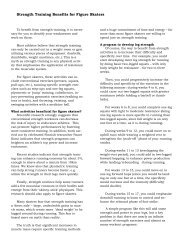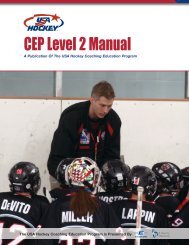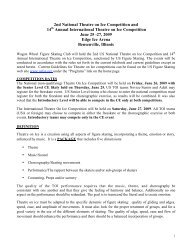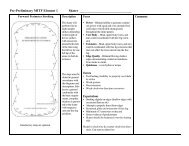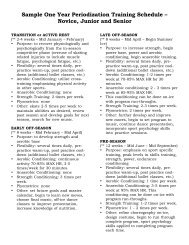'Synchronized Skating in College' Tip Sheet - US Figure Skating
'Synchronized Skating in College' Tip Sheet - US Figure Skating
'Synchronized Skating in College' Tip Sheet - US Figure Skating
Create successful ePaper yourself
Turn your PDF publications into a flip-book with our unique Google optimized e-Paper software.
Synchronized <strong>Skat<strong>in</strong>g</strong> In College:<br />
A Fact <strong>Sheet</strong> for High School Students<br />
WHAT DO I DO FIRST Each year, approximately 35 colleges participate <strong>in</strong> U.S. <strong>Figure</strong> <strong>Skat<strong>in</strong>g</strong>’s synchronized<br />
skat<strong>in</strong>g sectional championship, enter<strong>in</strong>g the open collegiate, collegiate and senior levels.*<br />
Perspective students can beg<strong>in</strong> f<strong>in</strong>d<strong>in</strong>g colleges that <strong>in</strong>terest them <strong>in</strong> two ways:<br />
1) To get an idea of how “competitive” teams are, look up the most recent results for these levels on Ice Network.<br />
Go to www.icenetwork.com and click on “schedule and results”. There you will f<strong>in</strong>d all of U.S. <strong>Figure</strong> <strong>Skat<strong>in</strong>g</strong>’s<br />
qualify<strong>in</strong>g events. Select the Eastern, Midwestern or Pacific Coast Synchronized <strong>Skat<strong>in</strong>g</strong> Sectional<br />
Championships, or the U.S. Synchronized <strong>Skat<strong>in</strong>g</strong> Championships to look up results for the open collegiate,<br />
collegiate or senior levels.<br />
2) For a list of all colleges with figure skat<strong>in</strong>g, go to the list of colleges on U.S. <strong>Figure</strong> <strong>Skat<strong>in</strong>g</strong>’s collegiate skat<strong>in</strong>g<br />
page: http://www.usfigureskat<strong>in</strong>g.org/Content/colleges.pdf<br />
Next, beg<strong>in</strong> research<strong>in</strong>g these schools by us<strong>in</strong>g their web sites. Look for the answers to questions you have about<br />
both the school and the synchronized skat<strong>in</strong>g team: Where are they located How many students attend these<br />
schools What majors are offered at these schools What is the campus like What level is the team plann<strong>in</strong>g on<br />
compet<strong>in</strong>g this year How competitive are tryouts for the team How much support does the team receive from<br />
their school<br />
After that, the <strong>in</strong>terested student (not the parent!) should contact the team’s capta<strong>in</strong>, coach or other listed person<br />
<strong>in</strong> a lead ship role to ask more specific and personal questions about the school and the team.<br />
WHY DO COLLEGES COMPETE IN SO MANY DIFFERENT LEVELS WHAT’S THE DIFFERENCE U.S. <strong>Figure</strong> <strong>Skat<strong>in</strong>g</strong><br />
provides several competitive options for synchronized teams comprised of college students. Teams select their<br />
competitive level based on the number of athletes they have, the <strong>in</strong>dividual skill level of those athletes, and the<br />
competitive goals of the team. It is also common for colleges to field teams <strong>in</strong> more than one level.<br />
OPEN COLLEGIATE: A team of 8-16 skaters, all of whom must be full-time college students. There is no U.S. <strong>Figure</strong><br />
<strong>Skat<strong>in</strong>g</strong> imposed m<strong>in</strong>imum moves-<strong>in</strong>-the-field test requirement for this level. Teams may compete at their respective<br />
sectional championships, but they do not advance to the U.S. Synchronized <strong>Skat<strong>in</strong>g</strong> Championships. On average,<br />
open collegiate teams practice about two hours per week on the ice.<br />
COLLEGIATE: A team of 12-20 skaters, all of whom must be full-time college students, and have passed at least the<br />
juvenile moves-<strong>in</strong>-the-field test.** Teams at this level compete at their respective sectional championships, and<br />
have the opportunity to advance to the U.S. Synchronized <strong>Skat<strong>in</strong>g</strong> Championships. Teams at the collegiate level<br />
practice an average of five hours per week on the ice.<br />
SENIOR: A team of 16 skaters, all of whom are at least 14 years old and have passed at least the novice moves-<strong>in</strong>the-field<br />
test**. Teams that have competed <strong>in</strong> senior recently <strong>in</strong>clude Miami University, the University of Delaware,<br />
the University of Michigan, the University of Wiscons<strong>in</strong> and Western Michigan University. Senior level teams have the<br />
opportunity to advance to the U.S. Synchronized <strong>Skat<strong>in</strong>g</strong> Championships, and to earn a spot <strong>in</strong> U.S. <strong>Figure</strong> <strong>Skat<strong>in</strong>g</strong><br />
<strong>in</strong>ternational envelope program, or even on the U.S. World Synchronized <strong>Skat<strong>in</strong>g</strong> Team. In 2007, Miami University<br />
became the first U.S. synchronized skat<strong>in</strong>g team to w<strong>in</strong> a medal – the silver – at the World Synchronized <strong>Skat<strong>in</strong>g</strong><br />
Championships. On average, senior teams spend about 7 hours and 30 m<strong>in</strong>utes per week on the ice.<br />
*Teams may skate at the junior level if all skaters are under 19. Junior teams have the opportunity to advance to the U.S.<br />
Synchronized <strong>Skat<strong>in</strong>g</strong> Championships, and to earn a spot <strong>in</strong> U.S. <strong>Figure</strong> <strong>Skat<strong>in</strong>g</strong> <strong>in</strong>ternational envelope program. See the U.S. <strong>Figure</strong><br />
<strong>Skat<strong>in</strong>g</strong> Rulebook rules 4670-4676 for more details about this level.<br />
**INDIVIDUAL SKATERS’ LEVELS: Although U.S. <strong>Figure</strong> <strong>Skat<strong>in</strong>g</strong> has test<strong>in</strong>g requirements for synchronized skat<strong>in</strong>g competitors,<br />
most skaters have passed tests beyond these requirements. Below is a breakdown of how many skaters passed moves-<strong>in</strong>-the-field<br />
tests beyond the requirements <strong>in</strong> 2009.<br />
Level Intermediate Novice Junior Senior<br />
Collegiate(National Competitors) 94% 81% 66% 50%<br />
Collegiate(Top 4 at U.S. Synchronized <strong>Skat<strong>in</strong>g</strong> Championships) 98% 87% 77% 63%<br />
Senior(Teams Represent<strong>in</strong>g Universities) 100% 100% 90% 77%<br />
Senior(Top 4 at U.S. Synchronized <strong>Skat<strong>in</strong>g</strong> Championships) 100% 100% 95% 90%
CAN I RECEIVE A SCHOLARSHIP AS A SKATER Currently, athletic scholarships are not available for skaters<br />
based on their participation <strong>in</strong> the sport. However, <strong>in</strong>dividual schools and programs offer a large variety of options<br />
for students look<strong>in</strong>g for f<strong>in</strong>ancial aid. Skaters, like all students, are able to apply for scholarships based on<br />
academics, need and many other criteria.<br />
PAYING FOR SKATING Teams handle f<strong>in</strong>ances a variety of ways related to the support they receive from their<br />
school:<br />
1) There are only two colleges <strong>in</strong> the U.S. that have a Varsity synchronized team – Miami University and Adrian<br />
College. These schools cover most team related expenses for their student athletes.<br />
2) Most other skat<strong>in</strong>g programs are recognized by their schools as club sports and receive some level of<br />
f<strong>in</strong>ancial support from their university.<br />
3) The average cost to skate on a collegiate or open collegiate team <strong>in</strong> the U.S. is $1,200. This number is<br />
significantly lower than the average cost of skat<strong>in</strong>g on a comparable team. Most teams receive some<br />
support from their school and all team members are try<strong>in</strong>g to balance the price of tuition with the skat<strong>in</strong>g,<br />
which makes fundrais<strong>in</strong>g a high priority.<br />
4) College teams are made up of full time students, and are often run by these students, so they all understand<br />
how expensive it is to attend college. This also provides students with a unique opportunity to ga<strong>in</strong> leadership<br />
experience and learn how teams are run while still participat<strong>in</strong>g <strong>in</strong> competitive skat<strong>in</strong>g.<br />
5) Your biggest expense as a collegiate skater, regardless of what school you attend, will always be tuition!<br />
All teams are different! It is important to contact a program directly to fully understand what k<strong>in</strong>d of f<strong>in</strong>ancial<br />
obligations exist for members of the team.<br />
ARE THERE OTHER CHOICES OUT THERE If the school you really want to attend doesn’t offer synchronized<br />
skat<strong>in</strong>g <strong>in</strong> some form, there are still other options available to college students wish<strong>in</strong>g to cont<strong>in</strong>ue or beg<strong>in</strong><br />
participat<strong>in</strong>g <strong>in</strong> the sport.<br />
1) Start your own team! All of the teams listed above had one person, at some po<strong>in</strong>t, who decided they wanted<br />
to skate on a team represent<strong>in</strong>g their university. Although it is sometimes difficult to start, every new team allows<br />
skaters to cont<strong>in</strong>ue skat<strong>in</strong>g without limit<strong>in</strong>g their college search. Guidel<strong>in</strong>es for do<strong>in</strong>g this are available <strong>in</strong> the<br />
collegiate programs section of U.S. <strong>Figure</strong> <strong>Skat<strong>in</strong>g</strong> Onl<strong>in</strong>e.<br />
2) You can also skate with local teams that are not affiliated with your university. College age athletes can<br />
compete <strong>in</strong> several levels on a wide variety of teams. Students successfully skate on local teams every year, <strong>in</strong><br />
fact, about half of the athletes <strong>in</strong> the senior division are college students. It is important to contact the team<br />
you wish to skate for early <strong>in</strong> the season. These teams generally beg<strong>in</strong> practice long before the school year<br />
beg<strong>in</strong>s. Contact<strong>in</strong>g a team early will also allow you to trouble shoot any potential problems before move <strong>in</strong><br />
day.<br />
I KNOW WHAT’S OUT THERE, NOW HOW DO I CHOOSE AND HOW DO I MAKE THE TEAM ONCE I GET<br />
THERE College teams are grow<strong>in</strong>g more competitive each year, and, <strong>in</strong> general, strive to have as high a test level<br />
as possible <strong>in</strong> all discipl<strong>in</strong>es before try<strong>in</strong>g out for a team. However, the variety of teams available to college<br />
students is also grow<strong>in</strong>g, which means there is a place for every skater, regardless of skat<strong>in</strong>g level or academic<br />
aspirations. After do<strong>in</strong>g basic research, the next step is to contact your favorite schools directly. Although this<br />
factsheet gives a basic overview of what to expect, every school is different! The only way to know what a program<br />
expects of its skaters is to ask directly. Visit<strong>in</strong>g campuses, watch<strong>in</strong>g practices and attend<strong>in</strong>g recruitment weekends<br />
are good ways to f<strong>in</strong>d out if the program meets your expectations of your collegiate experience.<br />
It is also important not to limit yourself to one or two schools based solely on their skat<strong>in</strong>g programs. Make sure to<br />
look at the whole school, not just the skat<strong>in</strong>g program. You will be spend<strong>in</strong>g only a few hours a day <strong>in</strong> the r<strong>in</strong>k, but<br />
you will be spend<strong>in</strong>g your entire day on the campus, <strong>in</strong> the classrooms, with the other students, and <strong>in</strong> the city or<br />
town your school is <strong>in</strong>. There are plenty of choices out there for students that allow you to stay <strong>in</strong>volved <strong>in</strong> skat<strong>in</strong>g<br />
(<strong>in</strong>clud<strong>in</strong>g creat<strong>in</strong>g a new team where one doesn’t exist yet!) while still consider<strong>in</strong>g academics, campus, location<br />
and all the other traditional factors used to compare schools when you make your f<strong>in</strong>al decision.<br />
GOOD LUCK!





